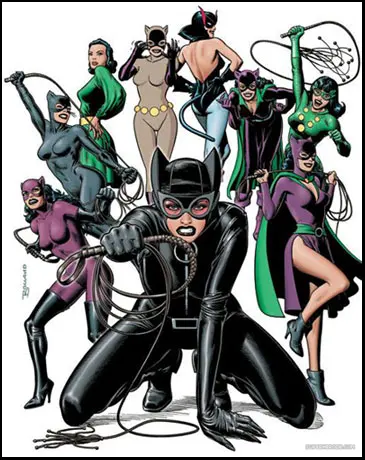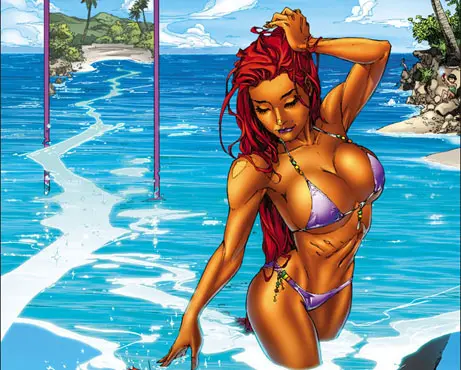September 21st 2011 - it's the date that will go down in history as the day I looked at my fellow comic book enthusiasts, shook my head in disgust, and hung it low from embarrassment. It's the day when the top news story wasn't about the immediate success of the DC 52 relaunch, or the first new issues of Scott Snyder's Batman and Brian Azzarello's Wonder Woman hitting the stands. No. It was about the fact that Catwoman was not only seen in her bra for a handful of panels, but capped off her first issue having sex with Batman. Fans were dismayed, shocked, sickened, and declared definitively that the relaunch was a complete and utter failure. Yes, one bra was all it took to set the comic book world on fire (well, that and Starfire herself, but more on that in a bit). While this was going on, however, people within the DC universe were also cutting off faces, gruesomely stabbing people, decapitating them by the wheelbarrow full, and being sadistically tortured in a number of horrific fashions. I sat there reading the message boards, dumbfounded by what had become a taboo subject - the sanctity of Catwoman's virtue (as if she ever had any to begin with) - and the complete dismissal of the violence that was scattered throughout the month's books. So when did a bra become more offensive than a decapitation?
Catwoman's bra is seen for exactly nine panels in Catwoman #1, and she has implied PG rated sex for three pages - that's it. And yet this resulted in people branding Judd Winick a misogynist and calling for his head on a stick. The thing people have failed to acknowledge is the context of the bra in question, as the opening panels reveal it's because Catwoman is forced to flee from her apartment after being discovered by some masked goons. So it's not like the shots are gratuitous and Catwoman is lounging around just for readers to ogle. It's a natural part of the scene in question. The second instance is more revealing than the opening panels, but once again it serves a purpose. Catwoman uses her sexuality in order to catch a murderer, who we can only assume, based on a brief flashback, is from a horrible time in Selina's past. The book then ends with Catwoman having sex with Batman, which seemed to be the final straw for many.
How could one issue cause such anger and hatred from the notoriously fickle comic community? One complaint was the issue of the bra itself, as it was seen as uncharacteristic for Selina, despite the fact that she probably wears one every day- but out of sight out of mind, right? When she's fully zipped up and in her Catwoman outfit, however, it's business as usual, as the skintight leather number has become the norm for the feline anti-hero. Let's take the outfit out of the question and look at the issue of skin, since that is what seemed to irk people the most. If you were to go back and look at how the character of Catwoman has evolved over the years, you'd see that she has always pushed the boundaries of sexuality. A costume with an opening to reveal her back. A v-cut costume to reveal her ample cleavage. Yet another v-cut costume to reveal her cleavage, with two slits up the side to show off her legs. Catwoman has never been a character who is the epitome of decency. If you take into account her more modern bodysuit costumes, ranging from her Batman: The Animated Series gray to her purple and eventually leather ensemble, they've always been hip-hugging outfits that accentuated her chest. An interesting point of fact: Catwoman was yanked from comics in 1954 because of the Comics Code Authority - which had guidelines concerning women and sexuality - and it took until 1966 for her to make her next appearance. So when it comes to the question of "decency," it's not like Catwoman has ever shied away from straddling the fence.

The second problem was in regards to this being the first time Batman and Catwoman - to the best of my knowledge - have consummated their relationship on the page. I ask, why is this a problem? Have these two not been in a love-hate tug-of-war for years, as both Batman and Catwoman, as well as Bruce Wayne and Selina Kyle? What's so wrong about two grown adults engaging in intimacy when they have obviously had feelings for each other for a long time? Fans accused writer Judd Winick of bastardizing the character, as if consensual sex is the last thing that Catwoman would ever have. Have people forgotten the history of Selina Kyle? In Frank Miller's Batman: Year One, Catwoman is depicted as a prostitute. In Catwoman: Year One, Selina decides to get off the radar of some local bad guys by going to work as a dominatrix. Following the One Year After storyline that took place after the Infinite Crisis event, we see that Selina has had a little girl named Helena. That means that somewhere along the way, everyone's favorite feline femme fatale got frisky at at least once. For that matter, if you look to the 1970s, Earth-Two actually had Batman and Catwoman as a married couple who had a child (that would go on to be known as The Huntress). When you look at all these instances combined - or even just one of them for that matter - it's hard to see how anyone could be offended by her having sex with Batman.
On the same day as the Catwoman fiasco, another DC character's sexuality was also a topic of discussion - Starfire. As depicted in Scott Lobdell's Red Hood and the Outlaws, Starfire is a woman who gets around. We know that's she's had sex with Jason Todd already, and despite one thinking there might be a relationship there, Starfire is quick to offer Arsenal his own encounter of the Tamaranean kind. We also gather that this is just a fling, as she quickly points out when Arsenal asks about the logistics of making love to one of her race. She responds by saying that "...love has nothing to do with it."
I can understand the complaints readers have had with Starfire's treatment more than Catwoman, but at the same time I question how much people know about these characters. Though she was never portrayed as a woman who gets around, Starfire's original origin is not unlike the one we see in the DC relaunch, as she began her life as Koriand'r - an alien princess who was sold into sexual slavery by her own sister. One could argue that Lobdell hasn't completely erased what Starfire once was, but embraced an element often never discussed. Where once she was a victim of rape, perhaps now she is taking back her power by using those who held sway over her. The simple fact is that we don't know yet, as the book has only had one issue. But that's still enough to make fans denounce it and burn it in holy effigy. There could be a great backstory behind Starfire's newfound sexual prowess, but it's sad that knee-jerk boycotters may never see her character fully realized.
I think a big reason behind the sexuality of these characters being a point of argument is the fact that DC Comic cartoons were probably the first introductions many readers had to them. Catwoman was flirty and had a sexy costume, but there was no skin on display. And because of the nature of cartoons, a relationship could never go beyond a date or a token kiss here and there. Starfire, meanwhile, was shown as a lovable young goof who cared about her friends in the Teen Titans, but this version of the character was a far cry from the adult version still playing a role in existing comics. One need only look at each version's costume to see how different the two were. I say the DC Comic cartoons are at fault to at least some degree because the sexuality in other books, where it was often more extreme, went largely overlooked due to the fact that these weren't wildly popular characters who fans grew up with through a cartoon medium. In Batwoman #1, for instance, there is more skin on display than seen in Catwoman. It's not just bra and panties either, as there are four panels with implied nudity, where the only reason you don't actually see anything is because of the careful positioning of an elbow, a person bending over, or a well-placed panel. How about Voodoo? Sure, the character has always been a stripper, but for many people the first issue of Voodoo #1 was probably their first real introduction to her, and almost the entire book is spent with her in several states of undress and engaged in provocative poses. Why didn't anybody raise a fuss over these two books when they got away with relatively "worse" material than either Catwoman or Red Hood and the Outlaws?

As I looked at the sexuality on display throughout DC's relaunch titles, I started to notice all the graphic violence from the former family friendly company, and that nobody was raising a fuss. There's no doubt that there have been grizzly deaths in some of DC's most well-known stories, but never to the extent that I witnessed in the new 52. Looking back on the month of September, I can't recall there being a week free of the graphic violence that used to be confined to DC's Vertigo imprint, and that of other, more independent comic book publishers.
So while Catwoman and Starfire were getting their freak on, here's what managed to get by without a word being said:
- All-Star Western - a dead prostitute is hung up as a message to Jonah Hex, who shoots five people and beats up almost everyone he comes across
- Grifter - a woman gets a pick to the eye and a man's neck is snapped in half
- Static Shock - someone gets their arm sliced off
- Demon Knights - an infant is used to channel a demon and then promptly killed
- Batman and Robin - one guy is shot multiple times in the head, while two others are boiled alive in acid
- Birds of Prey - a guy explodes
- Wonder Woman - two horses are decapitated and three girls are burned alive
- Batgirl - a guy is forced to drown in the water from a garden hose
- Batman – a man is found pinned to a wall with throwing knives
- Batwing - an entire precinct is killed, most by decapitation
- Deathstroke - two people are decapitated and numerous others are violently gunned down
- Detective Comics - a man's face is cut off
- Green Lantern - an alien is choked to death with piano wire
- Green Lantern Corps - another person is decapitated and two people are gutted/cut in half
- Red Lanterns - a person is killed by a brick to the head and an alien is sadistically tortured
- Suicide Squad - rats are encouraged to eat through a man's chest
- Swamp Thing - several people kill themselves by breaking their own necks
- Superboy - a guy explodes into a shower of blood
These aren't even all the instances, but rather a few of the more juicy ones. In most cases - the Detective Comics moment of violence leads the pack - these books have been celebrated for their dark, mature tones, and how far they push the envelope. A few of the books seem to warrant the violence, such as Deathstroke and Suicide Squad, but even those are pretty extreme for a DC book.
In almost all cases the violence is perpetrated by villains, so we as readers allow ourselves to let our guard down and accept it. But when did something as beautiful as the human body or something as natural as two people having sex end up trumping exploding bodies and decapitations? How come people are fine with a baby being killed during a ritual, yet they start metaphorically picketing when Catwoman shows a little skin? Have we become so desensitized to violence that it doesn't register? Are comic fans so afraid of the opposite sex (and sex in general) that they run and hide or try to shoo it away like a spider? I'm also curious as to how many people actually read the books in question, and how many simply saw the headlines, read a few outspoken reviewers, and declared their opinion to be the truth?
I hate having to ask so many rhetorical questions, but I'm simply baffled by the hypocrisy on display. How come we care so much about the issue of sex (which we view with blinders on), yet violence doesn't even registering as a blip on our radar?

About the author
Gamer, comic junkie, film fanatic, bibliophile, and writer.







